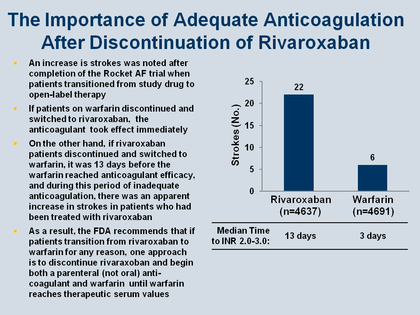Steven A. Rothman, MD - AFib Treatment: General Population - Figure 31
Adequate Anticoagulation After Discontinuation
The previous Figure discussed switching from a patient on warfarin to one of the newer anticoagulant agents. When undertaking the reverse – switching from a NOAC back to warfarin – the situation is more difficult, as shown in the Figure, looking at patients in the ROCKET AF trial[79] who were switched from rivaroxaban back to warfarin at the end of the trial.
As discussed in the presentation by Dr Reiffel (Figure 39), per the double-blind, double-dummy design of ROCKET AF, when the trial ended and patients were switched to open-label therapy, neither the physicians nor the patients knew whether the patient had been on rivaroxaban or warfarin during the trial. As a result, patients who had been on warfarin in the trial simply continued on warfarin, open-label, and their risk of stroke was maintained as it had been during the trial. For patients who had been on rivaroxaban, however, the drug was stopped, per protocol, and the choice of open-label warfarin was begun. The median time from termination of anticoagulation with the NOAC rivaroxaban to effective anticoagulation (INR 2.0 – 3.0) with the open-label warfarin, 13 days, meant that the serum levels of the anticoagulant were sub-therapeutic in these patients for almost 2 weeks, with the clear result of an increase in post-trial strokes.
In sum, in the case where a patient for any reasons switches from one of the NOACs to warfarin, the FDA recommends overlapping therapy to minimize the interruption of anticoagulation, suggesting concomitant administration of the warfarin and a parenteral anticoagulant agent until the warfarin reaches therapeutic INR levels.
Rothman SA. Am J Med 2013; 126: 00-00.
[ROCKET AF = Rivaroxaban Once Daily Oral Direct Factor Xa Inhibition Compared with Vitamin K Antagonism for Prevention of Stroke and Embolism Trial in Atrial Fibrillation]
[Editor's note: see an important update on this subject in the Note Added in Proof in the presentation on Novel Oral Anticoagulants, by James Reiffel, Figure 39.]

